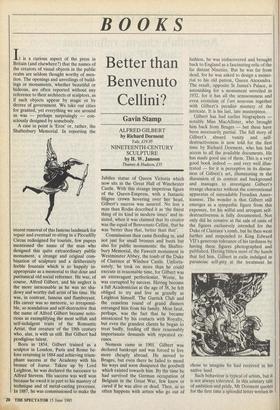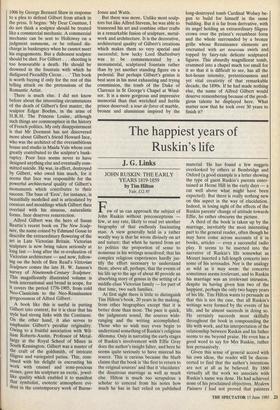BOOKS
It is a curious aspect of the press in Britain (and elsewhere?) that the names of the creators of visual objects in the public realm are seldom thought worthy of men- tion. The openings and unveilings of build- ings or monuments, whether beautiful or hideous, are often reported without any reference to their architects or sculptors, as if such objects appear by magic or by decree of government. We take our cities for granted, yet everything we see around us was — perhaps surprisingly — con- sciously designed by somebody.
A case in point is 'Eros' or, rather, the Shaftesbury Memorial. In reporting the recent removal of this famous landmark for repair and eventual re-siting in a Piccadilly Circus redesigned for tourists, few papers mentioned the name of the man who designed this quite extraordinary public monument, a strange and original com- bination of sculpture and a deliberately feeble fountain which is so happily in- appropriate as a memorial to that dour and puritanical old social reformer. He was, of course, Alfred Gilbert, and his neglect is the more inexcusable as he was no sha- dowy and worthy dull artist of his time. He was, in contrast, famous and flamboyant. His career was so meteoric, so irresponsi- ble, so scandalous and self-destructive that the name of Alfred Gilbert became noto- rious as exemplifying the most selfish and self-indulgent traits of the Romantic Artist, that creature of the 19th century who, alas, is with us still. But Gilbert had prodigious talent.
Born in 1854, Gilbert trained as a sculptor in London, Paris and Rome be- fore returning in 1884 and achieving trium- phant success at the Academy with his bronze of Icarus. Taken up by Lord Leighton, he was declared the successor to Alfred Stevens. His success was well won because he owed it in part to his mastery of technique and of metal-casting processes. In 1887, he was commissioned to make the
Better than Benvenuto Cellini?
Gavin Stamp
ALFRED GILBERT by Richard Dorment
Yale, £19.95
NINETEENTH-CENTURY SCULPTURE by H. W. Janson
Thames & Hudson, £35
Jubilee statue of Queen Victoria which now sits in the Great Hall of Winchester Castle. With this strange imperious figure of the Queen-Empress, with a fantastic filigree crown hovering over her head, Gilbert's success was assured. No less a man than Rodin described it as 'the finest thing of its kind in modern times' and in- sisted, when it was claimed that its creator was the equal of Benvenuto Cellini, that he was 'better than that, better than that'.
Commissions then came flooding in, and not just for small bronzes and busts but also for public monuments: the Shaftes- bury Memorial, the Fawcett monument in Westminster Abbey, the tomb of the Duke of Clarence at Windsor Castle. Unfortu- nately, he took on more than he could execute in reasonable time, for Gilbert was an extravagant perfectionist. Worse, he was corrupted by success. Having become a full Academician at the age of 38, he felt obliged to try and live as grandly as Leighton himself. The Garrick Club and the ceaseless round of grand dinners estranged him from his family. Most fatal, perhaps, was the fact that he became intoxicated by his contacts with Royalty, but even the grandest clients he began to treat badly, fending off their reasonably importunate demands with repeated ex- cuses.
Nemesis came in 1901. Gilbert was declared bankrupt and was forced to live more cheaply abroad. He moved to Bruges, but even there he failed to mend his ways and soon dissipated the goodwill which existed towards him. By the time he had survived the German occupation of Belgium in the Great War, few knew or cared if he was alive or dead. Then, as so often happens with artists who go out of
fashion, he was rediscovered and brought back to England as a fascinating relic of the far distant Nineties. But he was far from dead, for he was asked to design a memo- rial to his old patron, Queen Alexandra. The result, opposite St James's Palace, is astonishing for a monument unveiled in 1932, for it has all the sensuousness and even eroticism of l'art nouveau together with Gilbert's peculiar mastery of the intricate. It is his last, late masterpiece.
Gilbert has had earlier biographers — notably Miss MacAllister, who brought him back from Bruges — but these have been necessarily partial. The full story of Gilbert's absurd vanity and self- destructiveness is now told for the first time by Richard Dorment, who has had access to all the available documents. He has made good use of them. This is a very good book indeed — and very well illus- trated — for it is perceptive in its discus- sion of Gilbert's art, illuminating in the discussion of its context and background and manages to investigate Gilbert's strange character without the conventional apparatus of unreadable Freudian Amer- icanese. The wonder is that Gilbert still emerges as a sympathic figure from this exposure, for his wilful and arrogant self- destructiveness is fully documented. Not only did he connive at the sale of casts of the figures exclusively intended for the Duke of Clarence's tomb, but he then went further and responded to King Edward VII's generous tolerance of his tardiness by having these figures photographed and published. Having bitten most of the hands that fed him, Gilbert in exile indulged in paranoiac self-pity at the treatment he chose to imagine he had received in his native land.
Such behaviour is typical of artists, but it is not always tolerated. In this salutary tale of ambition and pride, Mr Dorment quotes for the first time a splendid letter written in
1906 by George Bernard Shaw in response to a plea to defend Gilbert from attack in the press. It begins: 'My Dear Countess, I do not think a sculptor should be treated like a commercial mechanic. A commercial mechanic can be sent to Holloway on a judgment summons, or be refused dis- charge in bankruptcy when he cannot meet his engagements. But a dishonest sculptor should be shot. For Gilbert. . . shooting is too honourable a death. He should be drowned in the fountain with which he disfigured Piccadilly Circus. . .' This book is worth buying if only for the rest of this telling attack on the pretensions of the Romantic Artist.
There is much else. I did not know before about the interesting circumstances of the death of Gilbert's first master, the sculptor Edgar Boehm, in the arms of H.R.H. The Princess Louise, although such things are commonplace in the history of French politics. My only disappointment is that Mr Dorment has not discovered more about Gilbert's friend Howard Ince, who was the architect of the overambitious house and studio in Maida Vale whose cost greatly contributed to the sculptor's bank- ruptcy. Poor Ince seems never to have designed anything else and eventually com- mitted suicide. He was, in effect, destroyed by Gilbert, who owed him much, for it seems that Ince was responsible for the powerful architectural quality of Gilbert's monuments which contributes to their success. The base of 'Eros', for instance, is beautifully modelled and is articulated by cornices and mouldings which Gilbert then overlaid with his sinuous, naturalistic forms. Ince deserves resurrection.
Alfred Gilbert was the hero of Susan Beattie's recent book on The New Sculp- ture, the name coined by Edmund Gosse to describe the extraordinary flowering of the art in Late Victorian Britain. Victorian sculpture is now being taken seriously at long last — long after the re-evaluation of Victorian architecture — and now, follow- ing on the heels of Ben Read's Victorian Sculpture comes the late H. W. Janson's survey of Nineteenth-Century Sculpture. This magnificently illustrated volume is both international and broad in scope, for it covers the period 1776-1905, from cold Neo-Classicism to the Neo-Renaissance gorgeousness of Alfred Gilbert.
A book like this is useful in putting Gilbert into context, for it is clear that his Style had strong links with the Continent. On the other hand, it also serves to emphasise Gilbert's peculiar originality. Owing to a fruitful association with Wil- liam Roberts-Austin, Professor of Metal- lurgy at the Royal School of Mines in South Kensington, Gilbert was a master of the craft of the goldsmith, of intricate filigree and variegated patina. This, com- bined with his delight in encrusting his Work with enamel and semi-precious stones, gave his sculpture an exotic, jewel- like quality which enabled it to manifest that symbolist, esoteric atmosphere evi- dent in the contemporary work of Burne- Jones and Watts.
But there was more. Unlike most sculp- tors but like Alfred Stevens, he was able to transcend his art and combine other crafts in a remarkable fusion of sculpture, metal- work and architecture. It is the decorative, architectural quality of Gilbert's creations which makes them so very special and successful; how lucky Lord Shaftesbury was to be commemorated by a monumental, sculptured fountain rather than by yet another standing figure on a pedestal. But perhaps Gilbert's genius is best seen in his most exhausting and trying commission, the tomb of the Duke of Clarence in St George's Chapel at Wind- sor. It is a more gorgeous and impressive memorial than that wretched and feeble prince deserved: a tour de force of marble, bronze and aluminium inspired by the long-destroyed tomb Cardinal Wolsey be- gan to build for himself in the same building. But it is far from derivative, with its angel holding an extraordinary filigree crown over the prince's recumbent form and the whole surrounded by a bronze grille whose Renaissance elements are encrusted with art nouveau swirls and, topped by fairy-tale delicate sculptured figures. This absurdly magnificent tomb, crammed into a chapel much too small for it so that it is difficult to see, has all the hot-house intensity, pretentiousness and yet vital creativity of that remarkable decade, the 1890s. If he had made nothing else, the name of Alfred Gilbert would deserve remembering because of the prodi- gious talents he displayed here. What matter now that he took over 30 years to finish it?



















































 Previous page
Previous page